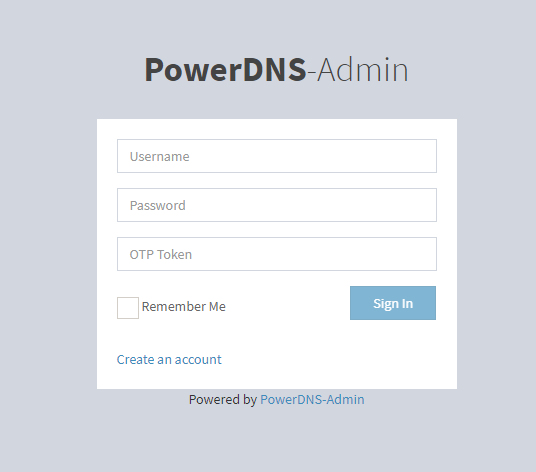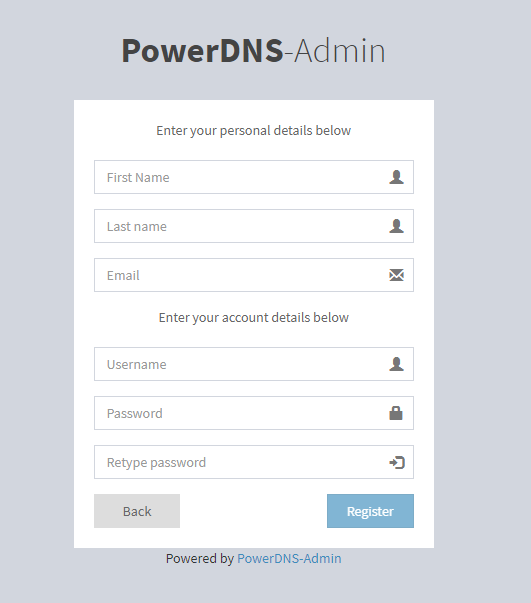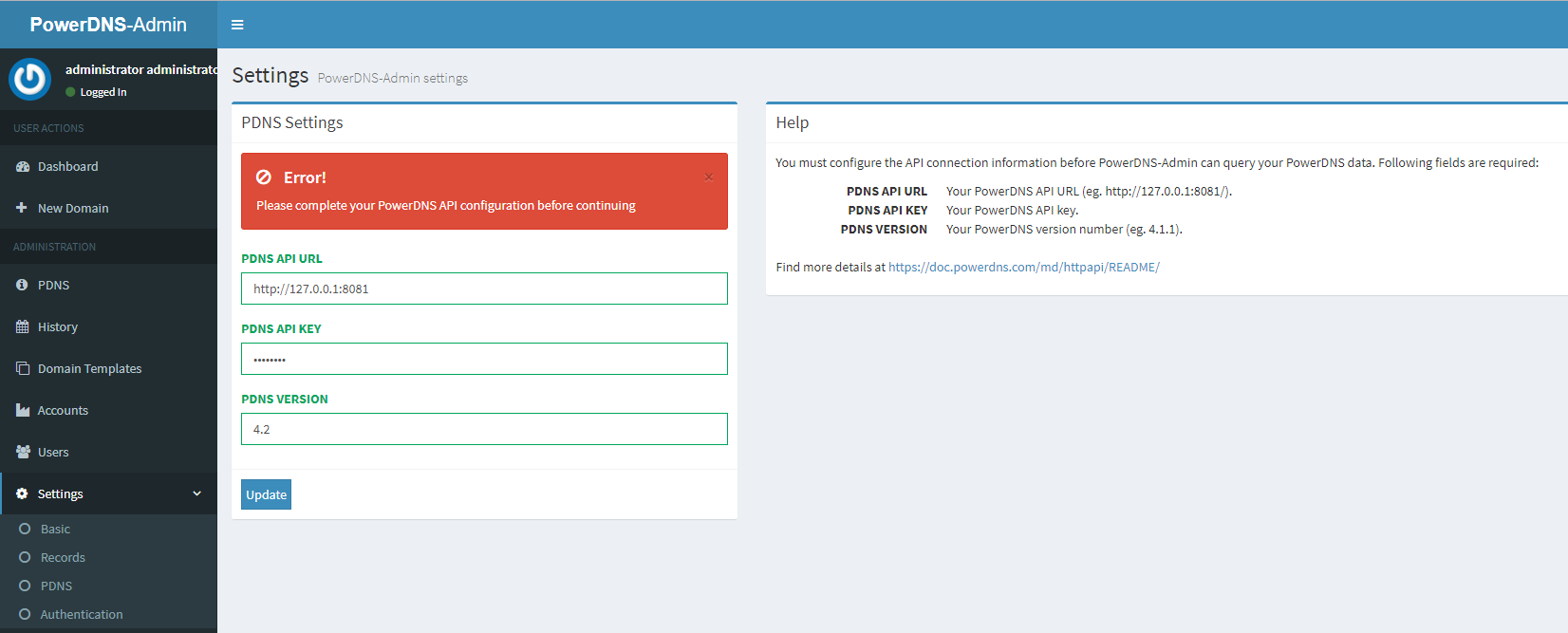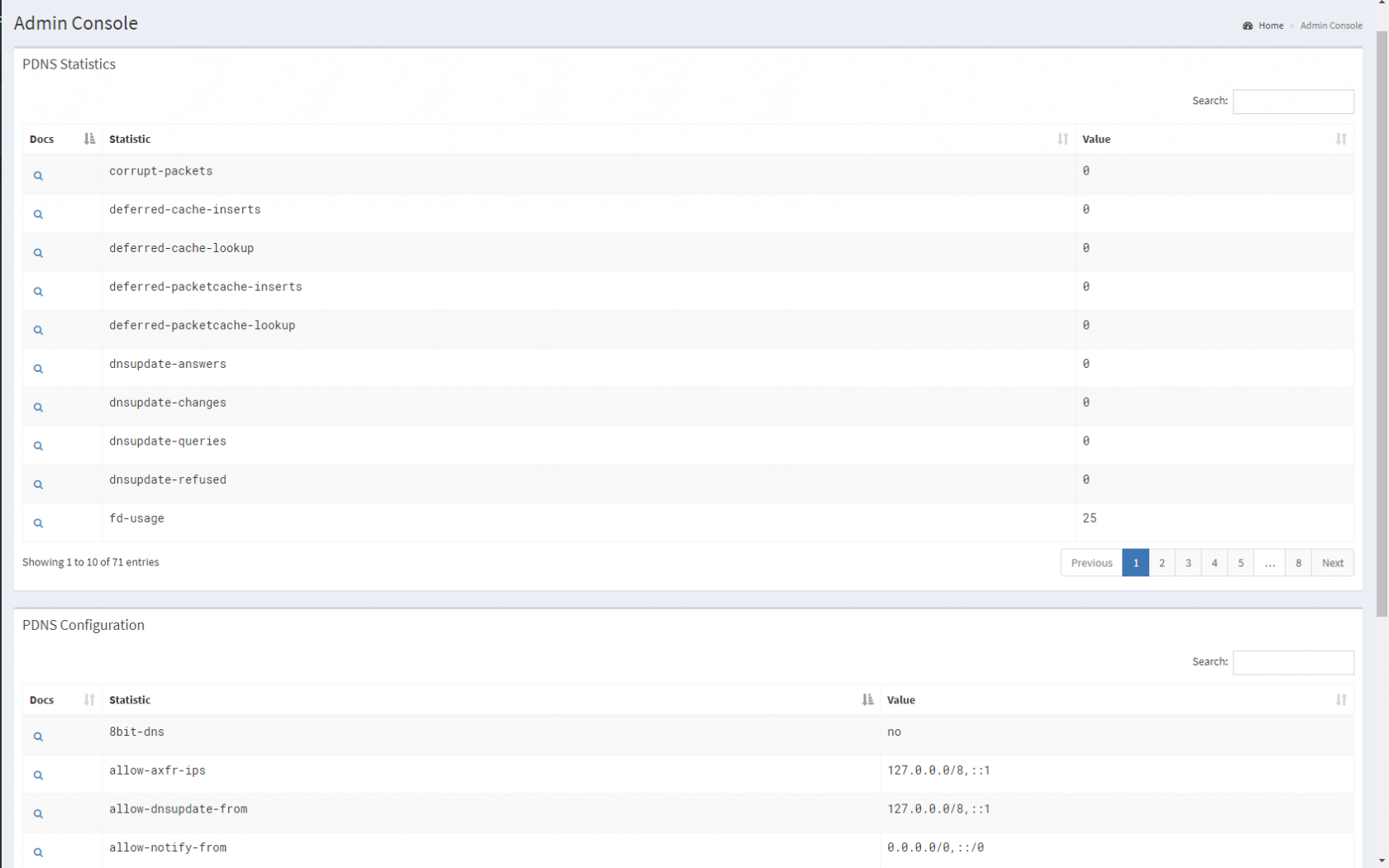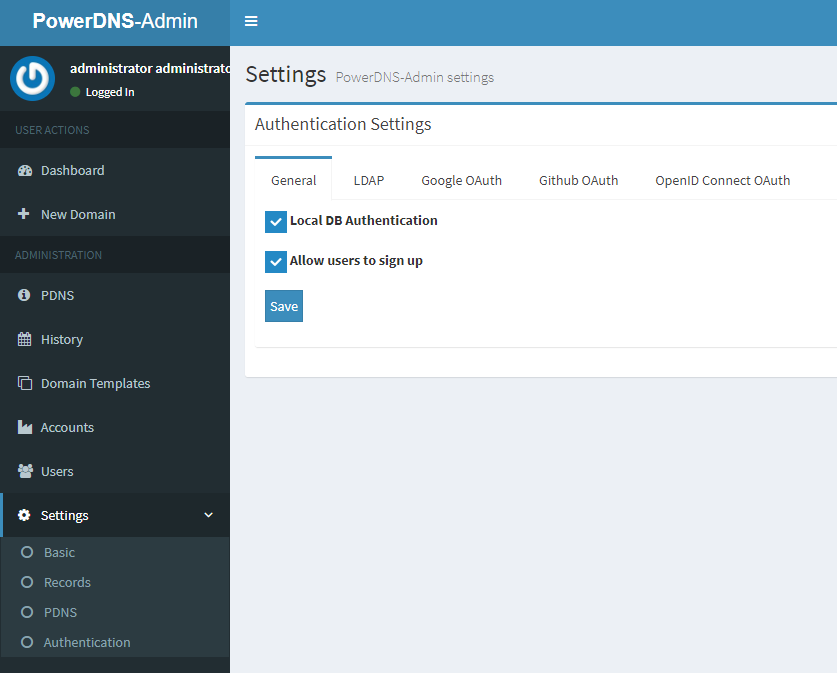PowerDNS 架設
BUBU 因為公司沒有內部用的 DNS 主機,所以需要新增一個 DNS 主機來架設給內部使用,找了一套適合並且又有網頁版的介面來操作,雖然沒有中文化。那目前我所設架的環境是 CentOS 7 下執行,版本是 PowerDNS 4.2版本。
網頁服務
安裝 nginx 服務
yum install nginx -y
資料庫
- BUBU 是採用 MariaDB 10.3 版本,來進行安裝
新增加MariaDB安裝檔
vim /etc/yum.repos.d/MariaDB.repo
再填入內容為以下
# MariaDB 10.3 CentOS repository list - created 2018-08-20 14:44 UTC
# http://downloads.mariadb.org/mariadb/repositories/
[mariadb]
name = MariaDB
baseurl = http://yum.mariadb.org/10.3/centos7-amd64
gpgkey=https://yum.mariadb.org/RPM-GPG-KEY-MariaDB
gpgcheck=1
增加完畢後在下命令安裝
yum install MariaDB-server MariaDB-client -y
- 設定資料庫
systemctl restart mariadb.service ; systemctl enable mariadb.service # 啟動資料庫服
mysql_secure_installation # 設定資料庫的root密碼
NOTE: RUNNING ALL PARTS OF THIS SCRIPT IS RECOMMENDED FOR ALL MariaDB
SERVERS IN PRODUCTION USE! PLEASE READ EACH STEP CAREFULLY!
In order to log into MariaDB to secure it, we'll need the current
password for the root user. If you've just installed MariaDB, and
you haven't set the root password yet, the password will be blank,
so you should just press enter here.
Enter current password for root (enter for none): 第一次設定,直接按 Enter 鍵即可
OK, successfully used password, moving on...
Setting the root password ensures that nobody can log into the MariaDB
root user without the proper authorisation.
Set root password? [Y/n] 按 Y 設定資料庫 root 密碼
New password: 輸入新密碼
Re-enter new password: 再次輸入新密碼
Password updated successfully!
Reloading privilege tables..
... Success!
By default, a MariaDB installation has an anonymous user, allowing anyone
to log into MariaDB without having to have a user account created for
them. This is intended only for testing, and to make the installation
go a bit smoother. You should remove them before moving into a
production environment.
Remove anonymous users? [Y/n] 按 Y 移除anonymous users
... Success!
Normally, root should only be allowed to connect from 'localhost'. This
ensures that someone cannot guess at the root password from the network.
Disallow root login remotely? [Y/n] 按 Y 關閉 root 遠端登入
... Success!
By default, MariaDB comes with a database named 'test' that anyone can
access. This is also intended only for testing, and should be removed
before moving into a production environment.
Remove test database and access to it? [Y/n] 按 Y 移除資料表 test
- Dropping test database...
... Success!
- Removing privileges on test database...
... Success!
Reloading the privilege tables will ensure that all changes made so far
will take effect immediately.
Reload privilege tables now? [Y/n] 按 Y 重新載入資料表權限
... Success!
Cleaning up...
All done! If you've completed all of the above steps, your MariaDB
installation should now be secure.
Thanks for using MariaDB!
- 設定 PowerDNS 權限
mysql -u root -p # 登入資料庫裡設定資表及權限
CREATE DATABASE powerdns CHARACTER SET utf8 COLLATE utf8_general_ci;
GRANT ALL ON powerdns.* TO 'powerdns'@'localhost' IDENTIFIED BY 'powerdns-password';
FLUSH PRIVILEGES;
增加 PowerDNS 必要的表單及欄位 4.2版本
USE powerdns;
CREATE TABLE domains (
id INT AUTO_INCREMENT,
name VARCHAR(255) NOT NULL,
master VARCHAR(128) DEFAULT NULL,
last_check INT DEFAULT NULL,
type VARCHAR(6) NOT NULL,
notified_serial INT UNSIGNED DEFAULT NULL,
account VARCHAR(40) CHARACTER SET 'utf8' DEFAULT NULL,
PRIMARY KEY (id)
) Engine=InnoDB CHARACTER SET 'latin1';
CREATE UNIQUE INDEX name_index ON domains(name);
CREATE TABLE records (
id BIGINT AUTO_INCREMENT,
domain_id INT DEFAULT NULL,
name VARCHAR(255) DEFAULT NULL,
type VARCHAR(10) DEFAULT NULL,
content VARCHAR(64000) DEFAULT NULL,
ttl INT DEFAULT NULL,
prio INT DEFAULT NULL,
disabled TINYINT(1) DEFAULT 0,
ordername VARCHAR(255) BINARY DEFAULT NULL,
auth TINYINT(1) DEFAULT 1,
PRIMARY KEY (id)
) Engine=InnoDB CHARACTER SET 'latin1';
CREATE INDEX nametype_index ON records(name,type);
CREATE INDEX domain_id ON records(domain_id);
CREATE INDEX ordername ON records (ordername);
CREATE TABLE supermasters (
ip VARCHAR(64) NOT NULL,
nameserver VARCHAR(255) NOT NULL,
account VARCHAR(40) CHARACTER SET 'utf8' NOT NULL,
PRIMARY KEY (ip, nameserver)
) Engine=InnoDB CHARACTER SET 'latin1';
CREATE TABLE comments (
id INT AUTO_INCREMENT,
domain_id INT NOT NULL,
name VARCHAR(255) NOT NULL,
type VARCHAR(10) NOT NULL,
modified_at INT NOT NULL,
account VARCHAR(40) CHARACTER SET 'utf8' DEFAULT NULL,
comment TEXT CHARACTER SET 'utf8' NOT NULL,
PRIMARY KEY (id)
) Engine=InnoDB CHARACTER SET 'latin1';
CREATE INDEX comments_name_type_idx ON comments (name, type);
CREATE INDEX comments_order_idx ON comments (domain_id, modified_at);
CREATE TABLE domainmetadata (
id INT AUTO_INCREMENT,
domain_id INT NOT NULL,
kind VARCHAR(32),
content TEXT,
PRIMARY KEY (id)
) Engine=InnoDB CHARACTER SET 'latin1';
CREATE INDEX domainmetadata_idx ON domainmetadata (domain_id, kind);
CREATE TABLE cryptokeys (
id INT AUTO_INCREMENT,
domain_id INT NOT NULL,
flags INT NOT NULL,
active BOOL,
content TEXT,
PRIMARY KEY(id)
) Engine=InnoDB CHARACTER SET 'latin1';
CREATE INDEX domainidindex ON cryptokeys(domain_id);
CREATE TABLE tsigkeys (
id INT AUTO_INCREMENT,
name VARCHAR(255),
algorithm VARCHAR(50),
secret VARCHAR(255),
PRIMARY KEY (id)
) Engine=InnoDB CHARACTER SET 'latin1';
CREATE UNIQUE INDEX namealgoindex ON tsigkeys(name, algorithm);
開始安裝 PowerDNS 服務
官方各系統的 套件載點 BUBU 是使用 Cetnos 7 系統為服務,當下安裝的版本為 PowerDNS 4.2
PowerDNS Authoritative Server - version 4.2
yum install epel-release yum-plugin-priorities -y &&
curl -o /etc/yum.repos.d/powerdns-auth-42.repo https://repo.powerdns.com/repo-files/centos-auth-42.repo &&
yum install pdns pdns-backend-mysql -y
PowerDNS Recursor - version 4.2
yum install epel-release yum-plugin-priorities &&
curl -o /etc/yum.repos.d/powerdns-rec-42.repo https://repo.powerdns.com/repo-files/centos-rec-42.repo &&
yum install pdns-recursor -y
Metronome - master branch
yum install epel-release yum-plugin-priorities &&
curl -o /etc/yum.repos.d/powerdns-metronome-master.repo https://repo.powerdns.com/repo-files/centos-metronome-master.repo &&
yum install metronome -y
dnsdist - version 1.4
yum install epel-release yum-plugin-priorities &&
curl -o /etc/yum.repos.d/powerdns-dnsdist-14.repo https://repo.powerdns.com/repo-files/centos-dnsdist-14.repo &&
yum install dnsdist -y
- 服務都安裝完之後開始設定兩個設定檔
PowerDNS 設定檔(Master)
- 備份預設檔,建立新的設定檔
mv /etc/pdns/pdns.conf /etc/pdns/pdns.conf.bak
vim /etc/pdns/pdns.conf
- 以下是我比較會異動到的設定檔,如果還要增加設定,請參考預設檔複製過來即可
#################################
# api Enable/disable the REST API (including HTTP listener)
#
# api=no
api=yes
#################################
# api-key Static pre-shared authentication key for access to the REST API
#
# api-key=
api-key=自行定義密碼
#################################
# daemon Operate as a daemon
#
daemon=yes
#################################
# guardian Run within a guardian process
#
guardian=no
#################################
# launch Which backends to launch and order to query them in
#
# launch=\nlaunch=
#
launch=gmysql
gmysql-host=localhost
gmysql-user=powerdns
gmysql-password=powerdns-password
gmysql-dbname=powerdns
gmysql-dnssec=yes
#################################
# local-address Local IP addresses to which we bind
#
# local-address=0.0.0.0
local-address=0.0.0.0
#################################
# local-port The port on which we listen
#
# local-port=53
local-port=54
#################################
# log-dns-details If PDNS should log DNS non-erroneous details
#
# log-dns-details=no
log-dns-details=yes
#################################
# log-dns-queries If PDNS should log all incoming DNS queries
#
# log-dns-queries=no
log-dns-queries=yes
#################################
# log-timestamp Print timestamps in log lines
#
# log-timestamp=yes
log-timestamp=yes
#################################
# logging-facility Facility to log messages as. 0 corresponds to local0
#
# logging-facility=
logging-facility=0
#################################
# loglevel Amount of logging. Higher is more. Do not set below 3
#
# loglevel=4
loglevel=4
#################################
# master Act as a master
#
# master=no
master=yes
#################################
# setgid If set, change group id to this gid for more security
#
setgid=pdns
#################################
# setuid If set, change user id to this uid for more security
#
setuid=pdns
#################################
# webserver Start a webserver for monitoring (api=yes also enables the HTTP listener)
#
# webserver=no
webserver=yes
#################################
# query-logging Hint backends that queries should be logged
#
# query-logging=no
query-logging=yes
- 設定自動啟動及重啟 PowerDNS 服務
systemctl enable pdns.service ; systemctl restart pdns.service
PowerDNS 設定檔 (Slave)
- 備份預設檔,建立新的設定檔
mv /etc/pdns/pdns.conf /etc/pdns/pdns.conf.bak
vim /etc/pdns/pdns.conf
- 以下是我比較會異動到的設定檔,如果還要增加設定,請參考預設檔複製過來即可
#################################
# api Enable/disable the REST API (including HTTP listener)
#
# api=no
api=yes
#################################
# api-key Static pre-shared authentication key for access to the REST API
#
# api-key=
api-key=自行定義密碼
#################################
# daemon Operate as a daemon
#
daemon=yes
#################################
# guardian Run within a guardian process
#
guardian=no
#################################
# launch Which backends to launch and order to query them in
#
# launch=\nlaunch=
#
launch=gmysql
gmysql-host=localhost
gmysql-user=powerdns
gmysql-password=powerdns-password
gmysql-dbname=powerdns
gmysql-dnssec=yes
#################################
# local-address Local IP addresses to which we bind
#
# local-address=0.0.0.0
local-address=0.0.0.0
#################################
# local-port The port on which we listen
#
# local-port=53
local-port=54
#################################
# log-dns-details If PDNS should log DNS non-erroneous details
#
# log-dns-details=no
log-dns-details=yes
#################################
# log-dns-queries If PDNS should log all incoming DNS queries
#
# log-dns-queries=no
log-dns-queries=yes
#################################
# log-timestamp Print timestamps in log lines
#
# log-timestamp=yes
log-timestamp=yes
#################################
# logging-facility Facility to log messages as. 0 corresponds to local0
#
# logging-facility=
logging-facility=0
#################################
# loglevel Amount of logging. Higher is more. Do not set below 3
#
# loglevel=4
loglevel=4
#################################
# slave Act as a slave
#
# slave=no
slave=yes
#################################
# slave-cycle-interval Schedule slave freshness checks once every .. seconds
#
# slave-cycle-interval=60
slave-cycle-interval=60
#################################
# setgid If set, change group id to this gid for more security
#
setgid=pdns
#################################
# setuid If set, change user id to this uid for more security
#
setuid=pdns
#################################
# webserver Start a webserver for monitoring (api=yes also enables the HTTP listener)
#
# webserver=no
webserver=yes
#################################
# query-logging Hint backends that queries should be logged
#
# query-logging=no
query-logging=yes
- 設定自動啟動及重啟 PowerDNS 服務
systemctl enable pdns.service ; systemctl restart pdns.service
PowerDNS Recursor 設定檔 這是負責遞迥查詢服務
- 備份預設檔,建立新的設定檔
mv /etc/pdns-recursor/recursor.conf /etc/pdns-recursor/recursor.conf.bak
vim /etc/pdns-recursor/recursor.conf
- 以下是我比較會異動到的設定檔,如果還要增加設定,請參考預設檔複製過來即可
#################################
# allow-from If set, only allow these comma separated netmasks to recurse
#
# allow-from=127.0.0.0/8, 10.0.0.0/8, 100.64.0.0/10, 169.254.0.0/16, 192.168.0.0/16, 172.16.0.0/12, ::1/128, fc00::/7, fe80::/10
allow-from=127.0.0.1, 192.168.0.0/24 #設定允許遞迥查詢內部網段
#################################
# forward-zones Zones for which we forward queries, comma separated domain=ip pairs
#
# forward-zones=
forward-zones=.=127.0.0.1:54 #轉送查詢的網域與伺服器,格式是 網域=伺服器ip,多個網域以逗點分隔
#################################
# forward-zones-recurse Zones for which we forward queries with recursion bit, comma separated domain=ip pairs
#
# forward-zones-recurse=
forward-zones-recurse=.=8.8.8.8, .=168.95.1.1 #內部查詢不到會查到外部查詢
#################################
# local-address IP addresses to listen on, separated by spaces or commas. Also accepts ports.
#
# local-address=127.0.0.1
local-address=0.0.0.0
#################################
# local-port port to listen on
#
# local-port=53
local-port=53
#################################
# logging-facility Facility to log messages as. 0 corresponds to local0
#
# logging-facility=
logging-facility=0
#################################
# max-negative-ttl maximum number of seconds to keep a negative cached entry in memory
#
# max-negative-ttl=3600
max-negative-ttl=3600
#################################
# setgid If set, change group id to this gid for more security
#
setgid=pdns-recursor
#################################
# setuid If set, change user id to this uid for more security
#
setuid=pdns-recursor
- 設定自動啟動及重啟 PowerDNS-Recursor 服務
啟動服務
systemctl start pdns-recursor ; systemctl enable pdns-recursor
PowerDNS-Admin 服務設定
- 安裝 Python 版,必要套件
yum update -y
yum install yum-utils -y
yum groupinstall development -y
安裝 IUM 套件庫
yum install \
https://repo.ius.io/ius-release-el7.rpm \
https://dl.fedoraproject.org/pub/epel/epel-release-latest-7.noarch.rpm
開始安裝 Python 3.6
yum install python36u python36u-pip python36u-devel -y
pip3.6 install -U pip
pip install -U virtualenv
rm -f /usr/bin/python3 && ln -s /usr/bin/python3.6 /usr/bin/python3
- 安裝 requirements.txt 構建 Pythone 套件
If you use MariaDB ( from MariaDB "upstream" repositorys (10.x) )
yum install gcc MariaDB-devel MariaDB-shared openldap-devel xmlsec1-devel xmlsec1-openssl libtool-ltdl-devel -y
- 安裝 yarn
curl -sL https://rpm.nodesource.com/setup_10.x | bash -
curl -sL https://dl.yarnpkg.com/rpm/yarn.repo -o /etc/yum.repos.d/yarn.repo
yum install yarn -y
安裝 PowerDNS-Admin
- 設定 PowerDNS 的 API
api=yes
api-key=your-powerdns-api-key
webserver=yes
- PowerDNS-Admin 建立資料庫
CREATE DATABASE powerdnsadmin CHARACTER SET utf8 COLLATE utf8_general_ci;
GRANT ALL PRIVILEGES ON powerdnsadmin.* TO 'pdnsadminuser'@'%' IDENTIFIED BY 'p4ssw0rd';
FLUSH PRIVILEGES;
quit;
- 安裝 PowerDNS-Admin
git clone https://github.com/ngoduykhanh/PowerDNS-Admin.git /opt/web/powerdns-admin
cd /opt/web/powerdns-admin
virtualenv -p python3 flask
- 進入 Python 模式並且開始安裝
. ./flask/bin/activate
(flask) [khanh@localhost powerdns-admin] pip install python-dotenv
(flask) [khanh@localhost powerdns-admin] pip install -r requirements.txt
- 安裝完之後設定 PowerDNS-Admin 設定檔
vim /opt/web/powerdns-admin/powerdnsadmin/default_config.py
- 修改設定檔如下
SECRET_KEY = 'We are the world' 在瀏覽器中對cookie進行簽名
BIND_ADDRESS = '127.0.0.1' 修改成 0.0.0.0 允許所有可以連線
PORT = 9191
SQLA_DB_USER = 'pdnsadminuser'
SQLA_DB_PASSWORD = 'powerdns-password'
SQLA_DB_HOST = '127.0.0.1'
SQLA_DB_PORT = 3306
SQLA_DB_NAME = 'powerdnsadmin'
SQLALCHEMY_TRACK_MODIFICATIONS = True
設定完存檔,並且開始安裝服務
- 運行下面指令自動建立 PowerDNS-Admin 資料庫裡的表單及欄位
(flask) [khanh@localhost powerdns-admin] export FLASK_APP=powerdnsadmin/__init__.py
(flask) [khanh@localhost powerdns-admin] flask db upgrade
- 產生資料檔
(flask) [khanh@localhost powerdns-admin] yarn install --pure-lockfile
(flask) [khanh@localhost powerdns-admin] flask assets build
- 運行 PowerDNS-Admin 服務
(flask) [khanh@localhost powerdns-admin] ./run.py
- 安裝完之後開始瀏灠器輸入
http://dns主機ip:9191如果看到登入畫面表示您已安裝成功了可以使用了
- 剛安裝完成官方並沒有預計任何的帳號,所以需要手動自行去建立帳號跟密碼輸入完之後就可以登入了
-
登入後會看到此頁面,要開輸入跟 PowerDNS 連接的 API
- API :http://127.0.0.1:8081
- API-kye:輸入當時所設定的密碼
- PDNS:輸入當時安裝的版本
- PowerDNS 版本查詢:
pdns_control version
-
設定完之後按下
Update就可以了
- 如果設定成功的話在 PDNS 選項裡面就可以看到 PDNS 目前設定狀況,如圖下
- 如果設定失敗的話,有可能是 api 的資訊有誤,跟版本或者密碼輸入有訊,如圖下是失敗的畫面,沒有連線成功的話後面新增網域的設定會有問題的。
- 再來進到設定裡面把預設可以讓使用者註冊給取消掉,把 Allow users to sign up 這個打勾給拿掉就可以了
108.12.23 以下這一段,照著官方的設定還是有問題,目前已有人提出問題,目前正在等待官方的回應。
109.01.03 官方是用 pdns 權限執行,修改成 root 就可以正常運行了
但是這樣子使用上並不方便,服務都需要手動去啟用,所以官方建議還需要寫個服務來啟用,並且搭配網頁服務來使用。
- 新增
powerdns-admin服務設定檔vim /etc/systemd/system/powerdns-admin.service
[Unit]
Description=PowerDNS-Admin
Requires=powerdns-admin.socket
After=network.target
[Service]
PIDFile=/run/powerdns-admin/pid
User=root
Group=root
WorkingDirectory=/opt/web/powerdns-admin
ExecStart=/opt/web/powerdns-admin/flask/bin/gunicorn --pid /run/powerdns-admin/pid --bind unix:/run/powerdns-admin/socket 'powerdnsadmin:create_app()'
ExecReload=/bin/kill -s HUP $MAINPID
ExecStop=/bin/kill -s TERM $MAINPID
PrivateTmp=true
[Install]
WantedBy=multi-user.target
- 新增
powerdns-admin.socket設定檔vim /etc/systemd/system/powerdns-admin.socket
[Unit]
Description=PowerDNS-Admin socket
[Socket]
ListenStream=/run/powerdns-admin/socket
[Install]
WantedBy=sockets.target
- 新增 powerdns-admin.conf 設定檔
vim /etc/tmpfiles.d/powerdns-admin.conf
d /run/powerdns-admin 0755 root root -
- 啟動服務
systemctl daemon-reload; sudo systemctl start powerdns-admin.socket; sudo systemctl enable powerdns-admin.socket
- Nginx 設定檔
server {
listen *:80;
server_name powerdns-admin.local www.powerdns-admin.local;
index index.html index.htm index.php;
root /opt/web/powerdns-admin;
access_log /var/log/nginx/powerdns-admin.local.access.log combined;
error_log /var/log/nginx/powerdns-admin.local.error.log;
client_max_body_size 10m;
client_body_buffer_size 128k;
proxy_redirect off;
proxy_connect_timeout 90;
proxy_send_timeout 90;
proxy_read_timeout 90;
proxy_buffers 32 4k;
proxy_buffer_size 8k;
proxy_set_header Host $host;
proxy_set_header X-Real-IP $remote_addr;
proxy_set_header X-Forwarded-For $proxy_add_x_forwarded_for;
proxy_headers_hash_bucket_size 64;
location ~ ^/static/ {
include /etc/nginx/mime.types;
root /opt/web/powerdns-admin/powerdnsadmin;
location ~* \.(jpg|jpeg|png|gif)$ {
expires 365d;
}
location ~* ^.+.(css|js)$ {
expires 7d;
}
}
location / {
proxy_pass http://unix:/run/powerdns-admin/socket;
proxy_read_timeout 120;
proxy_connect_timeout 120;
proxy_redirect off;
}
}
PowerDNS Log 記錄
因官方預設是關閉的,所要手動去啟用
systemctl edit --full pdns
看到 ExecStart 這一行將裡面的 --disable-syslog 刪除掉
去到 vim /etc/rsyslog.conf 增加給 PowerDNS 使用
local0.info -/var/log/pdns.info
local0.warn -/var/log/pdns.warn
local0.err /var/log/pdns.err
再去將 pdns.conf 及 recursor.conf 這兩個設定檔
修變這一行 logging-facility=0
以上修改完之後整個系統都重啟,就可以在 log 資料夾裡面看到這三個檔案
PowerDNS 支援 Active Directory 網域服務
PowerDNS 有支援動態更新 DNS 服務,在建置 AD 服務可以考慮將 DNS 設定指向 PowerDNS 服務來使用,修改 PowerDNS 配置文件使其支持动态更新。
vim /etc/pdns/pdns.conf
################################
# allow-dnsupdate-from A global setting to allow DNS updates from these IP ranges.
#
# allow-dnsupdate-from=127.0.0.0/8,::1
allow-dnsupdate-from=127.0.0.0/8
#################################
# dnsupdate Enable/Disable DNS update (RFC2136) support. Default is no.
#
# dnsupdate=no
dnsupdate=yes
- 添加修改解析記錄
@ SOA Active 3600 ns.adtest.com. ns.adtest.com. 2017112802 10800 3600 604800 3600
_kerberos._tcp SRV Active 3600 0 0 88 ad.adtest.com.
_kerberos._tcp.dc._msdcs SRV Active 3600 0 0 88 ad.adtest.com.
_ldap._tcp SRV Active 3600 0 0 389 ad.adtest.com.
_ldap._tcp.dc._msdcs SRV Active 3600 0 0 389 ad.adtest.com.
ad A Active 3600 192.168.50.207
ns A Active 3600 192.168.50.237
- PowerDNS-Admin 允許通過 DynDNS 更新需創建記錄域名面板中,進入需要修改的域名
Admin設定,在DynDNS 2 Settings勾選Allow on-demand creation of records via DynDNS updates?
參考相關網頁
- PowerDNS 官方載點
- Powerdns 4 on Centos 7 官方文件說明
- Install PowerDNS and PowerDNS-Admin on Ubuntu 18.04 / Debian 9 with MariaDB Backend
- CentOS 7 PowerDNS 安裝、設定
- 搭建一套权威 DNS 服务架构
- PowerDNS-Admin 官方
- Running PowerDNS Admin on Centos 7
- Running PowerDNS Admin with Systemd, Gunicorn and Nginx
- CentOS 7 中安装配置 PowerDNS、PowerAdmin 并结合 Windows Active Directory
- How-to install Python 3.6.1 on CentOS 7
- PowerDNS Authoritative Install Memo Part1
- PowerDNS Authoritative Install Memo Part2
- PowerDNS Recursorの導入
- CentOS7 - PowerDNS構築手順
- 【第一回PowerDNS】PowerDNSを建ててみました
- PowerDNS Master Slave DNS Replication with MySQL backend
- powerdns 架构更新说明

